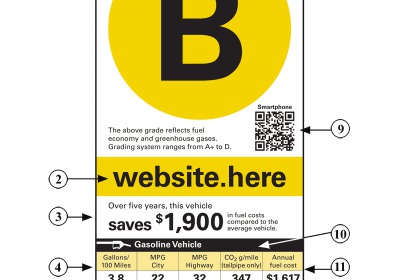New fuel-economy labels will baffle buyers, survey says
Wed, 06 Oct 2010A survey released this week suggests that revised fuel economy labels proposed by federal regulators will confuse many likely car buyers -- and will emphasize the wrong information.
The branding strategy firm Siegel+Gale performed an independent online survey of 456 people over the age of 18 who intended to buy a car in the next three years. Founder Alan Siegel told Automotive News that the survey was not directly requested but has been sent to the EPA and National Highway Traffic Safety Administration during the ongoing public comment period.
The EPA and NHTSA are redesigning the fuel economy label posted on the window sticker of all new cars and light-duty trucks to reflect the increasing number of alternative-fuel vehicles in the U.S. market.
The goal is to provide a comprehensive but understandable label and encourage customers to consider more fuel-efficient, environmentally friendly vehicles. The proposed new label comes in two main designs:
• The vertical version emphasizes a letter grade indicating the vehicle's comparative fuel economy.
• The horizontal version emphasizes a vehicle's fuel efficiency and emissions ratings.
Both versions also offer a QR code sticker -- a symbol that can be read by a smart phone -- for comparison with other vehicles.
While 66 percent of the survey respondents preferred the horizontal version, most respondents found some elements of both confusing. The vertical version confused 47 percent of respondents and the horizontal 38 percent. These percentages were only based on whether people perceived they understood the labels.
The survey also quizzed respondents on the terminology used on the labels.
Respondents were confused about the meaning of phrases such as miles per gallon equivalent (MPGe) -- 69 percent got it wrong with the vertical label and 62 percent with the horizontal version. Only about half of the people understood the reason for the letter grade on the vertical label. Respondents were also confused by the purpose of the smart-phone sticker.
Among the respondents, about 12 percent said they were “not eco-minded at all,” and 70 percent said they were eco-minded only if the pricing of the green options were similar to their gas-powered counterparts.
Respondents ranked annual fuel costs and fuel savings over five years as top considerations.
Low emissions and the type of car -- electric, hybrid or alternative fuel -- ranked last. Among consumers who viewed the horizontal version, 44 percent ranked mpg as the most important information labeled, and only 6 percent said greenhouse emissions were most important.
“The recommendations are simple: Scrap the vertical label, lose the letter grade and emphasize the mpg and cost of owning the vehicle,” Siegel said in a statement. “If the EPA takes these steps, it may be successful in increasing the number of fuel-efficient vehicles on the road and communicating clearly with consumers.”
Regulators will choose a final version of the label after the public comment period concludes at the end of November. The current label, which has been revised several times over its 30-year history, focuses on fuel economy values and annual fuel cost projections.
The EPA said it will respond to feedback after the public comment period.
By Vanessa R. Williams- Automotive News

